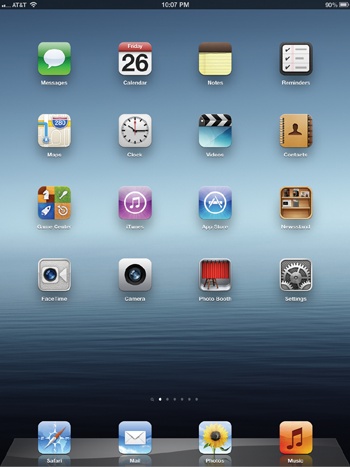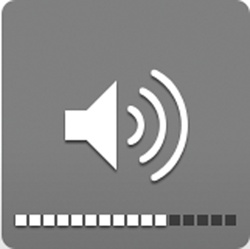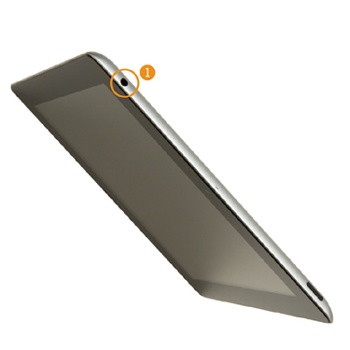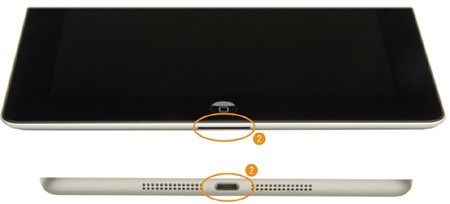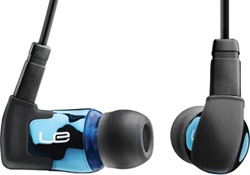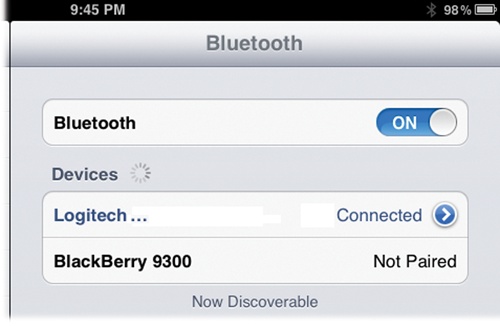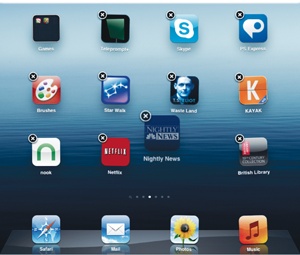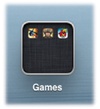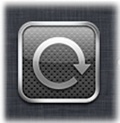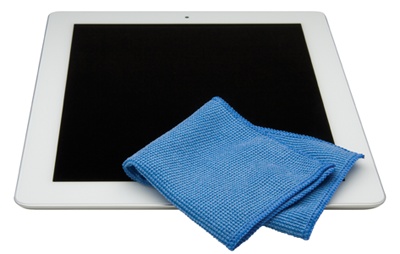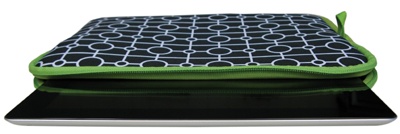Chapter 2. Tour Your Tablet
You’ll learn to:
Use the Home button to navigate, switch apps, and control music
Connect your iPad through jacks and ports
Tour the iPad’s apps
Organize apps with multiple Home screens and folders
AS A NEW IPAD owner, once you get past the tablet’s setup screens and installing iTunes if needed, the thrill of exploration and discovery can really begin. That’s where this chapter comes in—it guides you through the iPad’s physical controls and describes its built-in apps.
A full-size iPad comes with just a few switches and buttons. The iPad Mini, despite its smaller size, has the same arrangement of controls. No matter which model you own, you’ll learn what each button and switch does, and pick up tips and tricks for making them do more.
By contrast, your tablet comes with a lot of apps (20, to be exact), all neatly laid out across the Home screen (see opposite). You’ll learn what each mini-program does and where to go in this book to find out more.
Finally, since you’ll have your fingers all over the iPad’s screen as you tour your tablet, this chapter winds up with some advice for keeping that gorgeous screen clean and the iPad itself intact as you take it with you on all your tablet-computing adventures. And speaking of adventures, turn the page to start learning about your iPad.
Use the Home Button
AS YOU MAY RECALL, you met the iPad’s round Home button
(![]() ) back in Chapter 1,
when you set up your slab. But how the Home button behaves really
depends on what screen you’re on—and how many times you press
it:
) back in Chapter 1,
when you set up your slab. But how the Home button behaves really
depends on what screen you’re on—and how many times you press
it:
One click, anywhere. Press the button once and it takes you Home—back to the iPad’s main screen, where you’ll find all your apps. If you’re running an app and want to launch another one, click the Home button to return to the Home screen, where you can tap the new app open. You could be waist-deep in a Keynote presentation, for example (Create Presentations in Keynote), and want to watch an episode of The Big Bang Theory. Press the Home button to close Keynote (and automatically save your file) and go back to the main iPad screen, where you can tap the Videos icon to get to your shows.
One click on the first Home screen. You can have multiple Home screens (Navigate Multiple Home Screens), but when you’re on the first one, you can press the Home button once to go to the iPad’s universal Search screen (Search the iPad).
Double-click with an app open. While your iPad displays only one program at a time, it can run several apps at once, a process known as multitasking. The Home button is your ticket to switching among these active apps (flip to Use the Home Button to Switch Apps for more).
Double-click on the Lock screen. If your iPad has turned off its display to save power while you’ve got music playing, you can quickly get to the Music playback controls by double-clicking the Home button. As shown below, this double-whammy turns on both the iPad and its Lock screen (Turn the iPad On and Off), and displays a set of playback controls at the top of the screen (circled below).
Use the Mute/Lock and Volume Buttons
THE BUTTONS ON THE right edge of every iPad control the audio for movies, music, and apps that make noise. Here they are, from top to bottom:
Side Switch. The small black nub on the iPad’s right edge does one of two things, and it’s your call. Out of the box, the switch is a Mute button that silences the iPad’s audio alerts when you slide it down (until you see an orange dot). Slide the button up to restore your alerts.
If you don’t need a Mute button, you can turn the switch into a screen-orientation lock that keeps the iPad’s display in either the vertical or horizontal view so the screen doesn’t spin around as you move about. To lock the screen, press the Home button and tap Settings→General→“Use Side Switch to” and choose Lock Rotation. Choose Mute to go back to the way things were.
If you use the side switch to mute your iPad, you lock the screen’s orientation by double-clicking the Home button, swiping left-to-right in the panel of apps that appears, and tapping the Screen Orientation Lock (
 ). If you use the switch to lock the display,
you mute the iPad by turning the volume all the way down, as
described next.
). If you use the switch to lock the display,
you mute the iPad by turning the volume all the way down, as
described next.Volume. Press the top part of this switch to increase the volume of the iPad’s speaker (or your earbuds, if you’re wearing them; see Add Earbuds and Earphones). Press the bottom half of the switch to lower the volume. The iPad displays a little volume graphic so you can see where you are on the Relative Scale of Loudness.
Connect Through iPad Jacks and Ports
WHILE THE IPAD’S INNARDS are full of state-of-the-art electronics, the outside isn’t complex at all—just four buttons (On/Off-Sleep/Wake; Volume; Side Switch; and, discussed on Use the Home Button, the Home button). The outside of the iPad sports two jacks so you can plug in cords. Here’s what you do with ’em:
Headphone jack. Although it doesn’t come with its own set of headphones, as iPhones and iPods do, the iPad does offer a headphone jack on its top-left edge. You can plug in any pair of earbuds or headphones that come with the standard 3.5-millimeter stereo miniplug. The next page has more on that.
Lightning Port or Dock Connector. The flat port on the iPad’s bottom edge is called the Lightning port on the 4th-generation iPad and the iPad Mini, and the Dock Connector on older iPads. You plug the provided USB cable in here to connect your iPad to your computer for battery-charging, as well as for music, iBook, and video fill-ups from your iTunes libraries (unless you decide to go with the Wi-Fi Sync option, described on Sync Your iPad with iTunes). When buying accessories for your iPad. like external speakers and AV cables, make sure you get equipment that fits the port your iPad uses—or that you have an adapter handy. As you can see below, the Dock Connector (top) is much bigger than the petite Lightning port (below), so shop accordingly.
Note
You may notice two other features on the iPad’s outer edges (no, sadly, neither is a USB port or an SD card slot). The small hole in the center of the top edge is the iPad’s microphone for Voice Memos, FaceTime video chats, and other “listening” apps. And the perforated patch on the back near the Lightning port hides the iPad’s external speaker.
Add Earbuds and Earphones
WANT TO LISTEN PRIVATELY on your iPad? Back in the old days, the only headphones you could get came with a cord attached, and those still work just fine. But if you want to free yourself from wires while you lay back, relax, and listen to a Bach cello suite, get a pair of Bluetooth stereo headphones that connect wirelessly to the Bluetooth chip inside your iPad. Then, your only entanglement will be mind with music.
Here’s how you get either type of headphone to work on the iPad:
Wired. Pretty much any pair of headphones or earbuds with the ubiquitous 3.5mm stereo plug fits the iPad’s headphone jack. (Why, yes, you can use the familiar white earbuds from your iPod if you want.) Just be sure to push the plug firmly into the jack so it fully connects.
Bluetooth. When you shop for stereo Bluetooth headphones, look for those advertised as A2DP; they’re designed to play back music in stereo. To get them to work, you need to pair your headphones with the iPad. (Pairing means introducing two Bluetooth devices so they can communicate with each other; you only have to do this the first time you use the two devices together.)
The headphone manual tells you which button to push on the ’phones to pair the two. As for the iPad, start on the Home screen and tap Settings→Bluetooth (or Settings→General→Bluetooth in iOS 5). Then tap Bluetooth to On. The iPad looks around and once it finds your earphones, it lists them by name. If the headphones require a passkey (listed in the manual), the iPad keyboard appears so you can type it in. Once paired, the iPad screen says Connected next to a headphones icon, and the sound now plays over your wireless headphones.
Your Home Screen Apps
ONCE YOU ACTIVATE YOUR iPad, you’ll see 20 icons waiting for you in neat rows on the Home screen. They’re the programs that come free with your new iPad. These two pages tell you what each one does—and where you can find out more about it. So, using Apple’s standard placement, and starting at the top-left corner, here’s what you’ll see:
Messages. Use the Messages app to send free text messages to others using iOS 5 or later on their iPads, iPhones, and iPod Touches. Get details on Send Messages.
Calendar. As you may suspect, this is the app to tap when you need to check your schedule, make an appointment, or look up a date. Get the lowdown on Set Up Your Calendars.
Notes. This app serves as the iPad’s electronic scratch pad for jotting down quick thoughts or even full-blown ideas. And unlike a paper pad, you can email your notes right from the tablet. See Take Notes.
Reminders. Have a nagging feeling you need to do something or want to make sure you don’t forget a chore? Keep track of all your tasks on the iPad’s handy to-do list. Use Reminders has more.
Maps. When you need driving directions from Philadelphia to Provincetown—or you just want to look up an address—Maps is the app for you. Find Your Way with Maps tells you how to use this electronic atlas.
Clock. In iOS 6, the Clock app replaces YouTube on the iPad’s Home screen, letting users check time instead of killing it. As Track Time With the iPad’s Clock explains, you get not one clock, but four.
Videos. This app organizes and plays all your iPad’s movies, TV shows, and other videos. Chapter 15 is all about keeping yourself visually entertained.
Contacts. This app serves as your iPad’s address book—and it can even pull in the contacts file on your desktop computer so you don’t have to retype everything. See Maintain Contacts for details.
Game Center. Since it arrived in 2010, the iPad has become a popular videogame console, but you don’t have to play alone; tap Game Center to find games and friends. See Chapter 10 for lots more.
iTunes. Tap this shiny purple icon, and your iPad transports you right into Apple’s online emporium for all kinds of digital entertainment, including music, videos, games, and books. See The iTunes Store.
App Store. When the time comes to get yourself some cool new apps for your iPad, tap this bright blue beacon to go directly to Apple’s App Store and start shopping. See Chapter 8 for details.
Newsstand. Scores of magazines and newspapers come in digital editions just for the iPad. The Newsstand app keeps them all organized. See Use Newsstand for Your ePeriodicals for instructions.
FaceTime. Want to make a video call just like they do on the bridge of the USS Enterprise? The FaceTime app lets you videochat with pals on iOS devices. Make Video Calls with FaceTime explains how.
Camera. Both the newest iPad and the 2011 iPad 2 include a pair of cameras, and this app controls both. See Take Photos With the iPad’s Camera for info on taking still photos, and Shoot Your Own Videos for instructions on shooting videos.
Photo Booth. If you need a quick profile picture for your Facebook or LinkedIn page—or need to entertain the kids for an hour—tap open Photo Booth to snap creative self-portraits. See Take Portraits with Photo Booth for more.
Settings. Tap here to go to the controls that let you customize and adjust your iPad. This book discusses app settings when it describes the programs, but you can also get full descriptions in Appendix A.
Safari. When you feel like doing a little old-fashioned online surfing, tap here to fire up Safari, the iPad’s window to the Web. Chapter 5 is all about Safari.
Mail. Set up one email account—or several—and keep connected with your correspondents right on your iPad. Find out how to configure and use the Mail app in Chapter 6.
Photos. The iPad (especially the latest big models with the high- definition Retina display) is great for showing off your digital pictures. This app keeps them organized, as Chapter 16 explains.
Music. After Mac computers, Apple is best known for its iPod players, and the Music app turns your iPad into the biggest, flattest iPod yet. Chapter 14 tells you how to get your tunes cranking.
Organize Your Home Screen Icons
WHEN YOU GET FAMILIAR with all the built-in apps that come with your iPad, you may find yourself wishing you could put them in custom formation so you could, for example, find your most-used apps more quickly.
Luckily, Apple makes it easy to rearrange the icons right on your iPad. (You can also shift icons around in iTunes, as Sync and Organize Apps in iTunes explains). Here’s what you do:
Press your finger down on an icon for a few seconds until all the icons start wiggling.
As shown below, use your finger to drag the app’s icon around to a new location. Existing apps will slide over to make room. Drag the icon to the edge of the screen to move it to the next or previous page of your Home screen; the opposite page tells you more about that.
To delete an app, get it to wiggle (see step 1 above), and then tap the
 icon in its top-left corner. Uninstall Apps has more on deleting apps.
icon in its top-left corner. Uninstall Apps has more on deleting apps.
Once you press the Home button, your apps settle into their new locations. When you feel like moving things around again, just repeat these steps.
Navigate Multiple Home Screens
ONCE YOU START ADDING apps to your iPad, you may find the Home screen getting a little crowded. Fortunately, the iPad lets you have more than one of ‘em—in fact, you can have 11.
To navigate among Home screens, flick your finger across the iPad’s surface. The small white dots at the bottom of the screen (circled above) indicate how many Home screens you have and which one you’re on.
Once you start buying apps, you may find yourself filling up those 11 screens pretty quickly. If you don’t want to delete any apps, you can put them in folders. Turn the page to find out how.
Tip
Need to find an app on a crowded screen in a hurry—or just have too many apps for the iPad to display all their icons? Flick back to the first Home screen and flick left-to-right once more (or press the Home button) to call up the Search screen. Type in the name of the app and, when it shows up in the search results, tap it to launch it.
Make Home Screen App Folders
EVEN WITH A GENEROUS 11 Home screens, some app-loving folk can quickly fill them all with icons. In addition, some people might prefer a tidier way to group their apps, rather than dragging them around to different pages.
That’s where Home screen folders can make everything better. You can group up to 20 apps in a single folder—which looks like an icon with little icons nestled inside it (right). Putting apps in folders saves screen space and keeps common ones corralled.
To create a folder, press and hold an icon until it wiggles, and then drag it on top of another icon that you want in the same folder. A box appears with a generic name for the folder, like “Games” (see below). You can keep this name or replace it with one of your own, like “1980s Arcade Games.” Once you set up a folder, you can drag up to 18 more apps into it. Tap the screen to close the folder.
To get to an app inside a folder, tap the folder to open it, and then tap the app. If you change your mind and want to pull an app out of a folder, press and hold its icon to start the Wiggle Dance. Now you can drag the app out of the folder and back to its place on the Home screen proper.
To get rid of a folder altogether, press an icon to get all the icons wiggling. Drag all the apps out of the folder and back to the Home screen. When you take out the last app, the folder disappears.
Use the Home Button to Switch Apps
PUTTING APPS IN FOLDERS helps organize your iPad, but it doesn’t save you a lot of time when you’re in the middle of one app and want to switch over to another one real quick—like if you’re reading your email and want to nip out and turn on the Pandora radio app while you shovel out your Inbox. Who wants to go all the way out to the Home screen for that?
Fortunately, the iPad has a shortcut: Click the Home button twice. When you do, a row of icons sprouts from the bottom of your screen (below).
This row represents the apps you’ve recently used. Tap one to quickly switch back to it. Turn on Pandora, check your sports scores, or whatever. When you finish, double-click the Home button again. When the row of icons appears, tap the one for the app you began with to get back to it.
If the app you want isn’t in this initial row, flick the icons from right to left until you find it—all your recently used apps should be there.
Try to weed out apps you haven’t used in forever because their
icons take up memory and consume power. To do the ditch, press down on
an icon until the ![]() symbol appears. Tap the symbol to remove the app
from the recently used list—but not from the iPad itself. Press the Home
button when you finish. If your iPad is acting sluggish, forcibly
closing a ton of apps you’re not using may help.
symbol appears. Tap the symbol to remove the app
from the recently used list—but not from the iPad itself. Press the Home
button when you finish. If your iPad is acting sluggish, forcibly
closing a ton of apps you’re not using may help.
In addition to displaying your most recent apps, the Home button double-click offers another time-saver. Instead of flicking right to left to see recently used apps, flick left to right to find the music playback controls. This saves you the trouble of going out to the Music app’s Now Playing screen to skip a track in a playlist. The controls for streaming a file with AirPlay (Stream and Mirror Files with AirPlay) are here, too.
If you opted to make the iPad’s side switch a Mute button (Use the Mute/Lock and Volume Buttons) but get agitated when the screen reorients itself as you read an ebook in bed, swipe left and tap the first icon, the circular arrow in the left corner (right). That locks the iPad into its current orientation—until you tap the icon again to unlock the screen.
Keep the iPad Screen Clean
NOW THAT YOU’VE HAD your iPad tour, you probably realize that there’s one part of the gadget that’s very, very important to the whole tablet-computing experience.
Yes, like the iPhone and iPod Touch, the iPad and iPad Mini’s glass touchscreen is the main way you communicate with the slab. Each time you surf the Web or send some email, your fingers tap, slide, and flick across its smooth surface. Do this sort of thing on a normal piece of glass and you end up with a smudged and sticky window, gunked up from finger grease, moisturizer, and whatever else you have on your hands.
Thanks to a special coating (explained in the Note on the opposite page), the iPad’s screen tries to repel fingerprints. But with enough use, even that has its limits; your screen begins to look like a small child has been eating glazed doughnuts and touching your iPad repeatedly—with both hands. Here’s what you should—and shouldn’t—do to keep your iPad screen fresh and clean.
For smudges and smears on the glass, wipe the screen gently with a soft, lint-free cloth—the kind you use to clean a flat-panel TV screen, camera lens, or pair of glasses. A microfiber cleaning cloth is shown below.
Whatever you do, don’t use products like Windex, Formula 409, stuff from spray cans, ammonia- or alcohol-based cleansers, solvents, or a scratchy cleaning pad. These types of products compromise the screen’s special coating, and you don’t want that.
If the rest of the iPad gets schmutzed up, a quick cleaning session can return its shine. To buff it up, turn it off (Turn the iPad On and Off) and unplug it from any docks or USB cables. Then take a lightly water-dampened lint-free cloth and wipe down the iPad’s back and sides. Be careful not to slop water into openings like the headphone jack, Lightning port, Dock Connector, or speaker grill. Then wipe your slab down with a dry lint-free cloth.
Protecting the iPad’s Screen
The iPad screen is scratch-resistant, but it could break if you accidentally bounce the tablet off a concrete floor or have some other gravity-related mishap. If disaster strikes and you crack or chip the screen, don’t use the iPad or try to pry out the broken glass. Put it in a box or wrap it up to prevent glass shards from falling out, then take it to your nearest Apple Store or authorized Apple service provider for repair. Appendix B has more on iPad care and repair.
To protect your iPad as much as possible, both from accidental drops or even bouncing around in your shoulder bag alongside house keys, sunglasses, and loose credit cards, consider a case for it. Accessory makers have come up with a huge selection, from stately leather portfolio models to neon-colored rubber shells meant to jazz up your iPad or Mini while helping you keep a firm grip on the thing.
When considering a case, think about how you plan to carry and use your iPad. If it’s going to ride along in a backpack, a sturdy padded pouch may be more protective than a thin leather binder-type cover. Protect Your iPad has tips on the type of cases available and where to buy them.
Note
Apple describes the iPad’s screen as having a “fingerprint-resistant oleophobic coating,” which makes it sound like the device has some sort of psychiatric condition or a fear of butter substitutes (known as oleomargarine back in the day). Not to worry! Oleo, from the Latin oleum, just means “oil”—like the natural oils from your fingertips when you slide them around the iPad’s glossy screen. The oleophobic coating is just a plastic polymer applied to the iPad’s glass that’s supposed to cut down on smeary paw prints.

